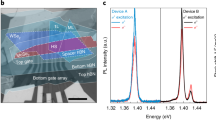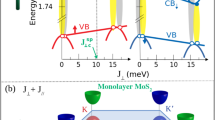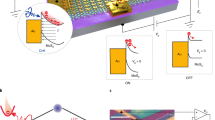Abstract
Electrically controlling the flow of charge carriers is the foundation of modern electronics. By accessing the extra spin degree of freedom (DOF) in electronics, spintronics allows for information processes such as magnetoresistive random-access memory1. Recently, atomic membranes of transition metal dichalcogenides (TMDCs) were found to support unequal and distinguishable carrier distribution in different crystal momentum valleys. This valley polarization of carriers enables a new DOF for information processing2,3,4. A variety of valleytronic devices such as valley filters and valves have been proposed5, and optical valley excitation has been observed2,3,4. However, to realize its potential in electronics it is necessary to electrically control the valley DOF, which has so far remained a significant challenge. Here, we experimentally demonstrate the electrical generation and control of valley polarization. This is achieved through spin injection via a diluted ferromagnetic semiconductor and measured through the helicity of the electroluminescence due to the spin–valley locking in TMDC monolayers6. We also report a new scheme of electronic devices that combine both the spin and valley DOFs. Such direct electrical generation and control of valley carriers opens up new dimensions in utilizing both the spin and valley DOFs for next-generation electronics and computing.
This is a preview of subscription content, access via your institution
Access options
Subscribe to this journal
Receive 12 print issues and online access
$259.00 per year
only $21.58 per issue
Buy this article
- Purchase on Springer Link
- Instant access to full article PDF
Prices may be subject to local taxes which are calculated during checkout




Similar content being viewed by others
References
Ali, M. N. et al. Large, non-saturating magnetoresistance in WTe2 . Nature 514, 205–208 (2014).
Cao, T. et al. Valley-selective circular dichroism of monolayer molybdenum disulphide. Nature Commun. 3, 887 (2012).
Zeng, H., Dai, J., Yao, W., Xiao, D. & Cui, X. Valley polarization in MoS2 monolayers by optical pumping. Nature Nanotech. 7, 490–493 (2012).
Mak, K. F., He, K., Shan, J. & Heinz, T. F. Control of valley polarization in monolayer MoS2 by optical helicity. Nature Nanotech. 7, 494–498 (2012).
Yao, W., Xiao, D. & Niu, Q. Valley-dependent optoelectronics from inversion symmetry breaking. Phys. Rev. B 77, 235406 (2008).
Xiao, D., Liu, G. B., Feng, W., Xu, X. & Yao, W. Coupled spin and valley physics in monolayer of MoS2 and other group-VI dichalcogenides. Phys. Rev. Lett. 108, 196802 (2012).
Zhu, B., Chen, X. & Cui, X. Exciton binding energy of monolayer WS2 . Sci. Rep. 5, 9218 (2015).
Ye, Z. et al. Probing excitonic dark states in single-layer tungsten disulfide. Nature 513, 214–218 (2014).
Chernikov, A. et al. Exciton binding energy and nonhydrogenic Rydberg series in monolayer WS2 . Phys. Rev. Lett. 113, 076802 (2014).
Mak, K. F., Lee, C., Hone, J., Shan, J. & Heinz, T. F. Atomically thin MoS2: a new direct-gap semiconductor. Phys. Rev. Lett. 105, 136805 (2010).
Splendiani, A. et al. Emerging photoluminescence in monolayer MoS2 . Nano Lett. 10, 1271–1275 (2010).
Lagarde, D. et al. Carrier and polarization dynamics in monolayer MoS2 . Phys. Rev. Lett. 112, 047401 (2014).
Xu, X., Yao, W., Xiao, D. & Heinz, T. F. Spin and pseudospins in layered transition metal dichalcogenides. Nature Phys. 10, 343–350 (2014).
Ovchinnkov, D., Allain, A., Huang, Y., Dumcenco, D. & Kis, A. Electrical transport properties of single-layer WS2 . ACS Nano 8, 8174–8181 (2014).
Ross, J. S. et al. Electrically tunable excitonic light-emitting diodes based on monolayer WSe2 p–n junctions. Nature Nanotech. 9, 268–272 (2014).
Baugher, B. W. H., Churchill, H. O. H., Yang, Y. & Jarillo-Herrero, P. Optoelectronic devices based on electrically tunable p–n diodes in a monolayer dichalcogenide. Nature Nanotech. 9, 262–267 (2014).
Pospischil, A., Furchi, M. M. & Mueller, T. Solar-energy conversion and light emission in an atomic monolayer p–n diode. Nature Nanotech. 9, 257–161 (2014).
Zhang, Y. J., Oka, T., Suzuki, R., Ye, J. T. & Iwasa, Y. Electrically switchable chiral light-emitting transistor. Science 344, 725–728 (2014).
Cheng, R. et al. Electroluminescence and photocurrent generation from atomically sharp WSe2/MoS2 heterojunction p–n diodes. Nano Lett. 14, 5590–5597 (2014).
Cheiwchanchamnangij, T. & Lambrecht, W. R. L. Quasiparticle band structure calculation of monolayer, bilayer, and bulk MoS2 . Phys. Rev. B 85, 205302 (2012).
Ross, J. S. et al. Electrical control of neutral and charged excitons in a monolayer semiconductor. Nature Commun. 4, 1474 (2013).
Zhang, Y. et al. Direct observation of the transition from indirect to direct bandgap in atomically thin epitaxial MoSe2 . Nature Nanotech. 9, 111–115 (2014).
Korn, T., Heydrich, S., Hirmer, M., Schmutzler, J. & Schüller, C. Low-temperature photocarrier dynamics in monolayer MoS2 . Appl. Phys. Lett. 99, 102109 (2011).
Ohno, Y. et al. Electrical spin injection in a ferromagnetic semiconductor heterostructure. Nature 402, 790–792 (1999).
Flederling, R. et al. Injection and detection of a spin-polarized current in a light-emitting diode. Nature 402, 787–790 (1999).
Ghosh, S. & Bhattacharya, P. Surface-emitting spin polarized In0.4Ga0.6As/GaAs quantum-dot light-emitting diode. Appl. Phys. Lett. 80, 658–660 (2002).
Chen, L. et al. Easy axis reorientation and magneto-crystalline anisotropic resistance of tensile strained (Ga,Mn)As films. J. Magn. Magn. Mater. 322, 3250–3254 (2010).
Kioseoglou, G. et al. Valley polarization and intervalley scattering in monolayer MoS2 . Appl. Phys. Lett. 101, 221907 (2012).
Yu, T. & Wu, W. Valley depolarization due to intervalley and intravalley electron–hole exchange interactions in monolayer MoS2 . Phys. Rev. B 89, 205303 (2014).
Olejník, K. et al. Enhanced annealing, high Curie temperature, and low-voltage gating in (Ga,Mn)As: A surface oxide control study. Phys. Rev. B 78, 054403 (2008).
Wang, Q. et al. Valley carrier dynamics in monolayer molybdenum disulfide from helicity-resolved ultrafast pump-probe spectroscopy. ACS Nano 7, 11087–11093 (2013).
Zhu, B., Zeng, H., Dai, J., Gong, Z. & Cui, X. Anomalously robust valley polarization and valley coherence in bilayer WS2 . Proc. Natl Acad. Sci. USA 111, 11606–11611 (2014).
Acknowledgements
The authors acknowledge financial support from Office of Naval Research Multidisciplinary University Research Initiative program under grant no. N00014-13-1-0649, and National Science Foundation (EFMA-1542741). J.Z. and H.W. acknowledge support from MOST of China (grant no. 2015CB921503) and NSFC (grant no. 61334006). Y.Y. thanks T. Cao of the University of California, Berkeley for helpful discussions.
Author information
Authors and Affiliations
Contributions
Y.Y., X.Y., Z.Y. and X.Z. conceived the project. H.W. and J.Z. grew and characterized (Ga,Mn)As films. Y.Y., H.Z. and M.Z. developed the sample design and fabricated the samples. Y.Y., J.X. and Z.Y. performed the measurements. Y.Y. and J.X. carried out the data analysis. Y.Y., X.Y. and J.X. wrote the manuscript. X.Z., X.Y. and Y.W. guided the research. All authors discussed the results and commented on the manuscript.
Corresponding author
Ethics declarations
Competing interests
The authors declare no competing financial interests.
Supplementary information
Supplementary information
Supplementary information (PDF 1683 kb)
Rights and permissions
About this article
Cite this article
Ye, Y., Xiao, J., Wang, H. et al. Electrical generation and control of the valley carriers in a monolayer transition metal dichalcogenide. Nature Nanotech 11, 598–602 (2016). https://doi.org/10.1038/nnano.2016.49
Received:
Accepted:
Published:
Issue Date:
DOI: https://doi.org/10.1038/nnano.2016.49
This article is cited by
-
Raman scattering excitation in monolayers of semiconducting transition metal dichalcogenides
npj 2D Materials and Applications (2024)
-
Room temperature valley polarization via spin selective charge transfer
Nature Communications (2023)
-
Selective enriching of trionic emission in a WS2-ZnO hybrid through type-II band alignment
Science China Information Sciences (2023)
-
Recent developments in CVD growth and applications of 2D transition metal dichalcogenides
Frontiers of Physics (2023)
-
Modulating the intralayer and interlayer valley excitons in WS2 through interaction with AlGaN
Science China Materials (2023)



